How Can Businesses Cut Cloud Costs Without Losing Performance?
The adoption rate for the cloud has increased dramatically in the last two years especially with the onset of the pandemic and incorporation of the hybrid workforce model. Organizations are continuously looking to improve their work operations along with making sure that they are streamlined and coherent with their cloud spending.
Moving to a cloud platform can have many benefits for a business and with Azure containing more than 200 products/cloud services, this can significantly help your organization to deal with your growing and unique IT needs. Read on to learn more about migrating to the cloud using Azure migration tools and tactics.
Related Blogs
All you need to know about Azure Cloud Migration: Best Practices
Differences Between Windows 365 & Azure Virtual Desktop: Comparison
Cloud Migration Triggers
There are several triggers that that can potentially drive the conversation of moving to Azure:
📑 Datacenter contract expiry: If you are in a hosted location and your contract is up for renewal that can often be a great time to look at Azure to see whether it's a better fit for your organization than extending your current contract.
📈 Business continuity: If your business needs are continuously growing then that might be the right time to move to Azure. If you have applications that are continuing to grow at a faster rate than anticipated and if you need to purchase additional hardware to support that growth, transitioning that application to Azure can be a good fit (as you can leverage unlimited space available to you).
💰Cash flow challenges: From a cash flow perspective, migrating to Azure is a very cost-effective mechanism. There is no need to buildout secondary data centers and all the associated hardware. Capex and making large capital investments can be a challenge for organizations and moving to Azure can give more flexibility as it doesn’t require you to predict growth for the future and allows you to just focus on today.
⚠️ Cybersecurity threats: From a security standpoint, there are numerous security products packed into Azure and they are very easy to deploy. It's just a matter of running through a bit of configuration and you can typically have them up in substantially less time than it would take to deploy a similar solution on-prem.
⚙️ Budget and resource constraints: Azure migration can help a great deal when it comes to budget and resource constraint scenarios. It gives you the ability to flip from Capex(capital expenditures)to Opex (operations expense) where you do not have to worry about your future infrastructure growth (large capital upfront) and only pay for what you consume today. It also gives you the flexibility to scale up/down resources depending on what's happening within the business.
🌐 For rapid scaling of web apps and infrastructure: Deploying new servers and infrastructure on-premises can be quite time consuming. It can literally take time to set up infrastructure, configure applications from the ground up, modify it and make sure that they are running correctly, whereas deploying technologies within Azure typically only take a couple of clicks and can get you to production much faster.
How to get started with an Azure migration journey using Cloud Adoption Framework (CAF)?
For organizations that are looking to transition to Azure or incorporate that as part of their infrastructure – it can often be daunting and challenging to figure out where to start and how best to proceed. Microsoft has developed their cloud adoption framework or CAF to help provide guidance to customers along this path. They have a number of different phases.
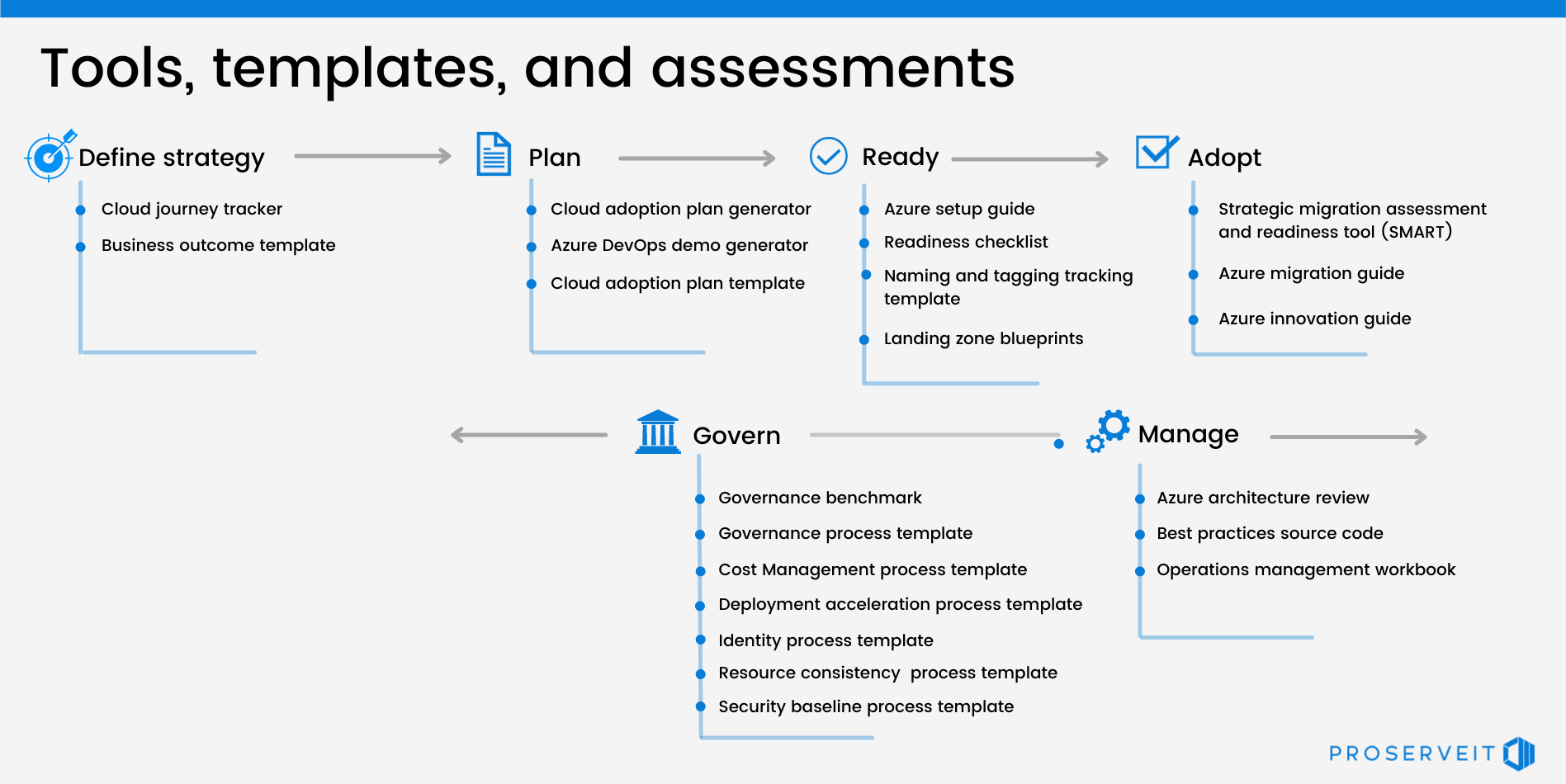 From Strategy definition through planning, readiness and adoption and then underlying governance and management models - under each of these different phases Microsoft provides a range of tools, templates and assessments to help customers along their Azure journey. Along with providing guidance and a lot of documentation to generate conversation, these templates can also help accelerate the adoption of Azure or determine whether azure is a good fit.
From Strategy definition through planning, readiness and adoption and then underlying governance and management models - under each of these different phases Microsoft provides a range of tools, templates and assessments to help customers along their Azure journey. Along with providing guidance and a lot of documentation to generate conversation, these templates can also help accelerate the adoption of Azure or determine whether azure is a good fit.
From a strategy definition perspective, you can leverage the cloud journey tracker and business outcome template. The business outcome template can help you to understand what information should be captured and presented to the business to validate whether Azure is going to be a good fit.
Under planning there are various plan generators and plan templates available. Under the ready phase we have readiness checklists, tagging templates, landing zone blueprints. There's a wide range of tools under each of these categories and these are all free tools provided by Microsoft and are designed to make life easier for customers. Trying to migrate to Azure (given the size and breadth of what azure brings to bear) can sometimes be daunting. Leveraging some of the investments that Microsoft has made in these tools, templates and assessments can help expedite some of those processes and help provide a guided path along the journey.
For those organizations looking at Azure in the near to mid-term, it’s a great place to start to leverage “the strategic migration assessment and readiness tool” or “smart tool”. This tool provides a series of questions to help gauge where your business is from a readiness perspective for Azure. So, each of the different categories will help you identify whether you are ready for Azure; whether there's still room for growth or whether there's maybe an area that's considered critical because there hasn't been any preliminary work done around that.
These tools also give you a quick view into where you are from a readiness perspective; it helps you understand where you should focus effort and time and ensure that you have all the right foundational elements in place. This means as you start your Azure journey, everything that's required from a foundational perspective has ideally been put in place.
Adopt Cloud: Migrate
Before proceeding with migration execution, it is required that all the upstream steps of strategy, planning and readiness are completed. Key deliverable assets of these phases include – cloud Adoption Plan template and a landing zone configuration.
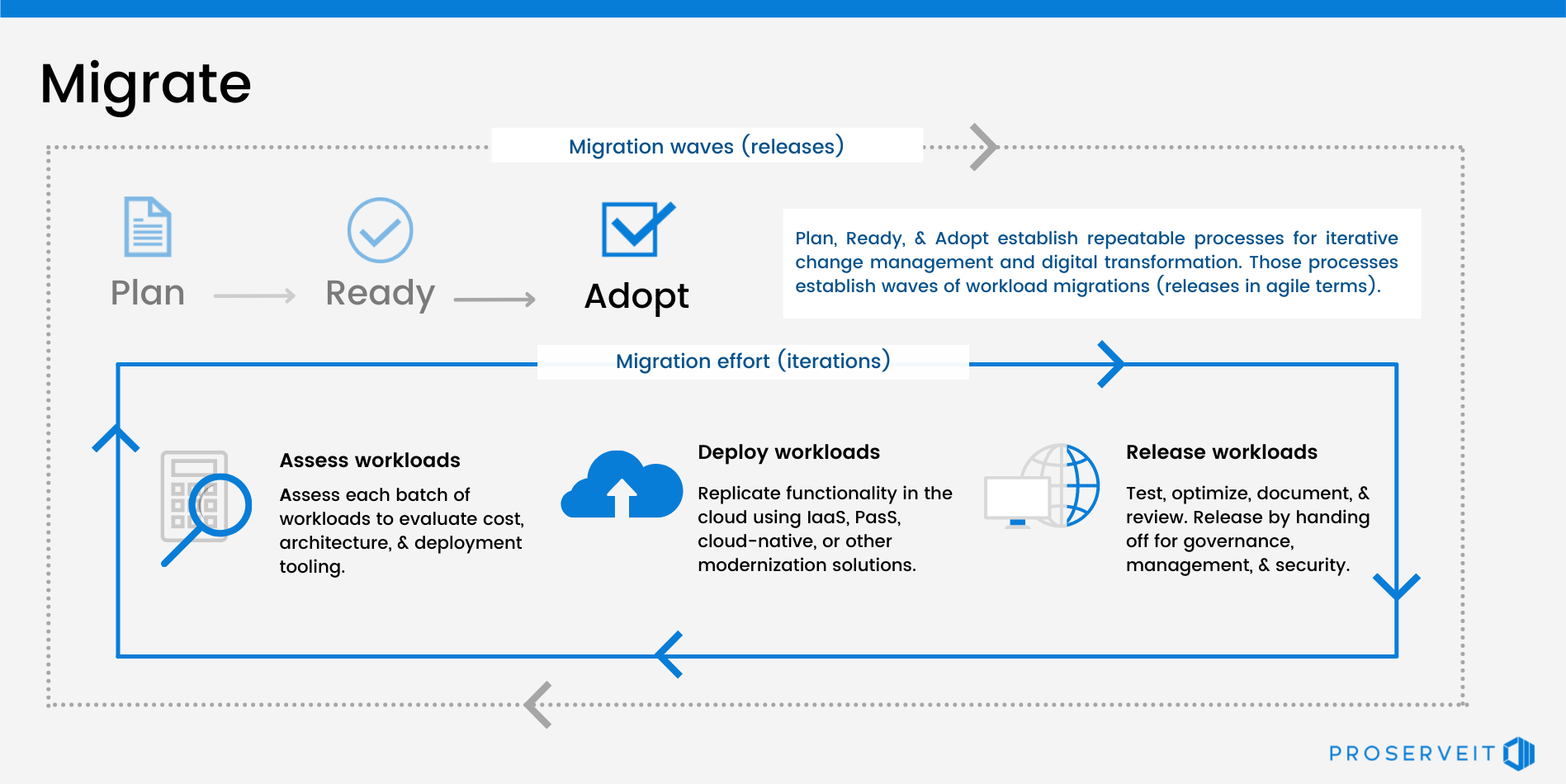 When we look through the Azure migration journey, specifically through the cloud adoption framework, there are elements that fall under planning and readiness. Creation of planning templates and landing zone configurations are basically your initial setup for Azure. This defines things like naming conventions, tagging and network environment, topology or hierarchy and security. These elements, when combined roll into what's called a landing zone.
When we look through the Azure migration journey, specifically through the cloud adoption framework, there are elements that fall under planning and readiness. Creation of planning templates and landing zone configurations are basically your initial setup for Azure. This defines things like naming conventions, tagging and network environment, topology or hierarchy and security. These elements, when combined roll into what's called a landing zone.
This is basically how Azure is configured but as we get into adoption, there are different applications and programs available to help drive these conversations.
It's very rare that an organization makes the decision to move to Azure on a whim. Typically, Azure migrations are an iterative process and over a period of time you can identify good initial candidates, transition those into Azure, get a sense as to how that's working for the business, determine what you did right versus where there's areas for improvement and then continue to evolve and expand your capabilities.
Migration Tooling Options
When we talk about migration tooling, Microsoft provides a wide range of tools that can be leveraged to plan out and conduct an Azure migration. Through assessment, deployments and release, there are different tools available including data migration and a SQL server migration assistant to help with SQL migrations.
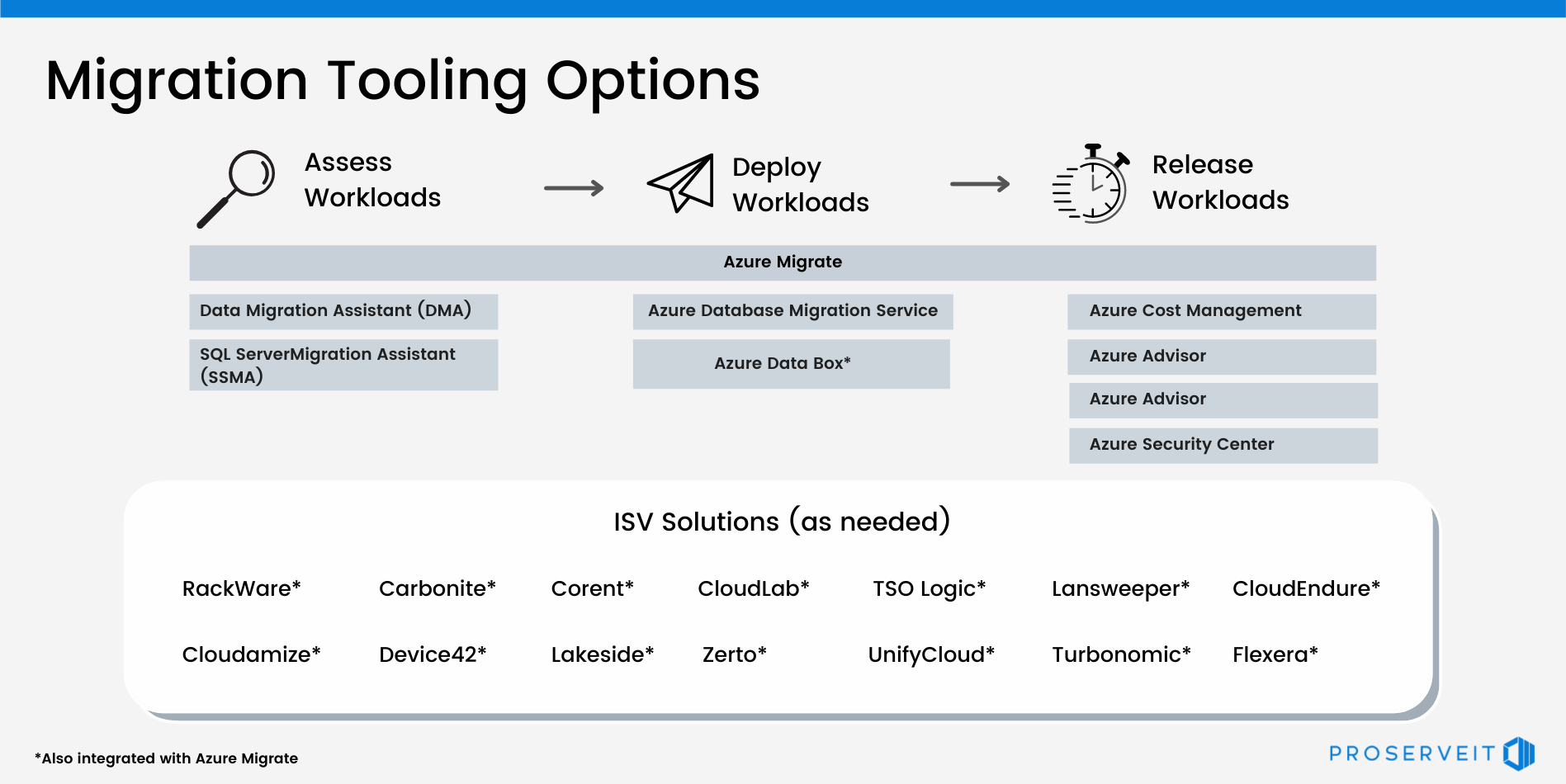 An Azure database migration service, data box for transitioning files, data cost management and even third-party tools integration - all these are standalone activities or standalone applications (i.e., they have their own interface or their own portals or their own landing page). Managing these tools can be challenging for organizations who have multiple workload scenarios. Even balancing migrating different aspects of the business into Azure as a whole can be challenging. This is where Azure Migrate comes into the picture.
An Azure database migration service, data box for transitioning files, data cost management and even third-party tools integration - all these are standalone activities or standalone applications (i.e., they have their own interface or their own portals or their own landing page). Managing these tools can be challenging for organizations who have multiple workload scenarios. Even balancing migrating different aspects of the business into Azure as a whole can be challenging. This is where Azure Migrate comes into the picture.
What is Azure Migrate?
Azure Migrate is a central hub for all your data center migration requirements. With Azure migrate you get a single pane of glass visibility throughout the life cycle of your Azure migration journey.
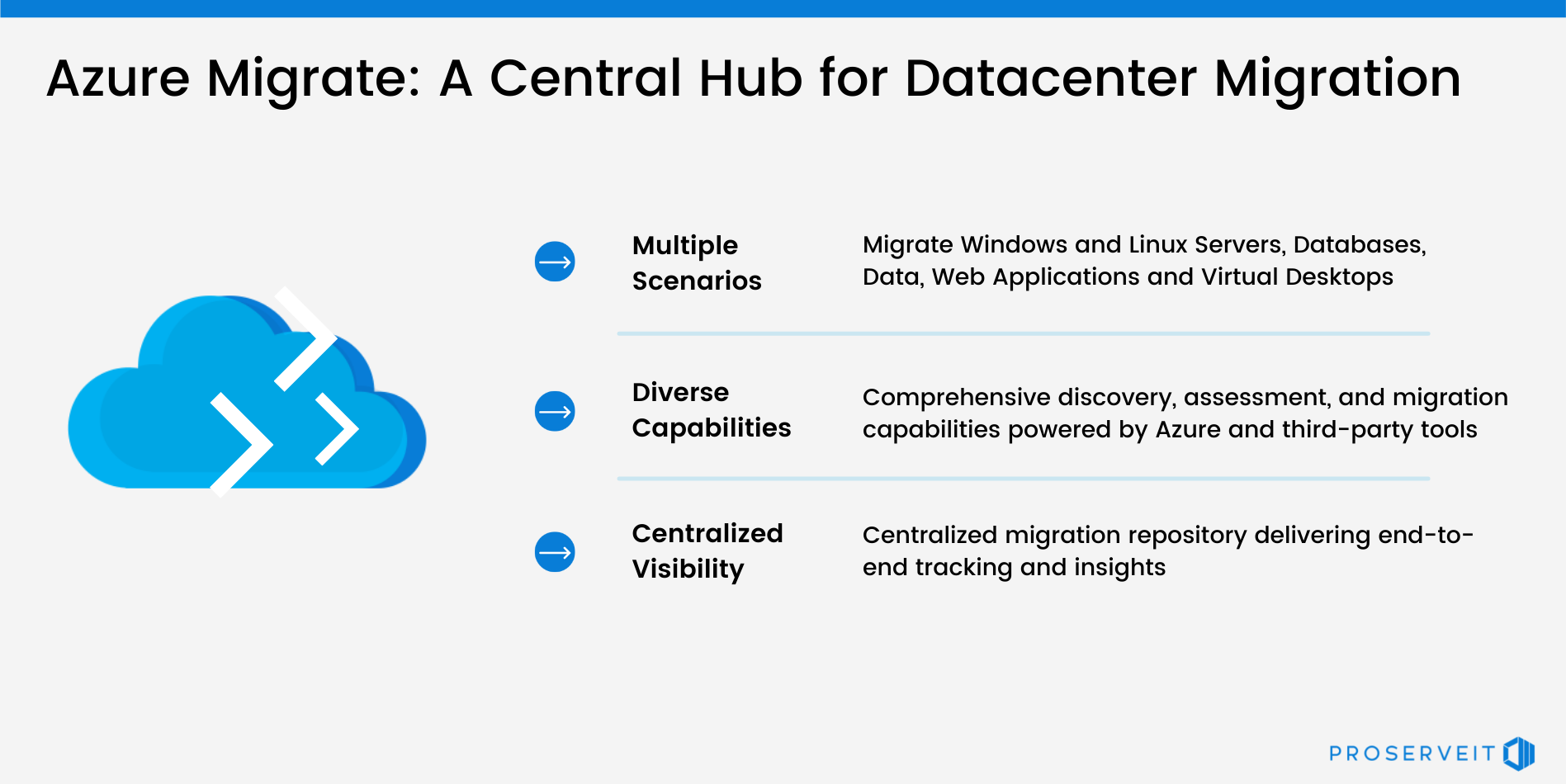 From a scenario perspective, this tool set will allow you to manage Windows and Linux servers, databases, data web applications, and virtual desktops. It also allows you to basically work through the entire life cycle of your migration - from your initial assessment and discovery straight through the migration itself.
From a scenario perspective, this tool set will allow you to manage Windows and Linux servers, databases, data web applications, and virtual desktops. It also allows you to basically work through the entire life cycle of your migration - from your initial assessment and discovery straight through the migration itself.
From a centralized view, when we talk about migration scenarios and workloads, the Azure migrate tool set supports Windows and Linux servers, databases, data, virtual desktops and web apps. These migration tools will allow you to manage that journey as well and drop those databases, for example, directly into a platform as a service or a SQL PaaS instance versus running against a traditional virtual machine.
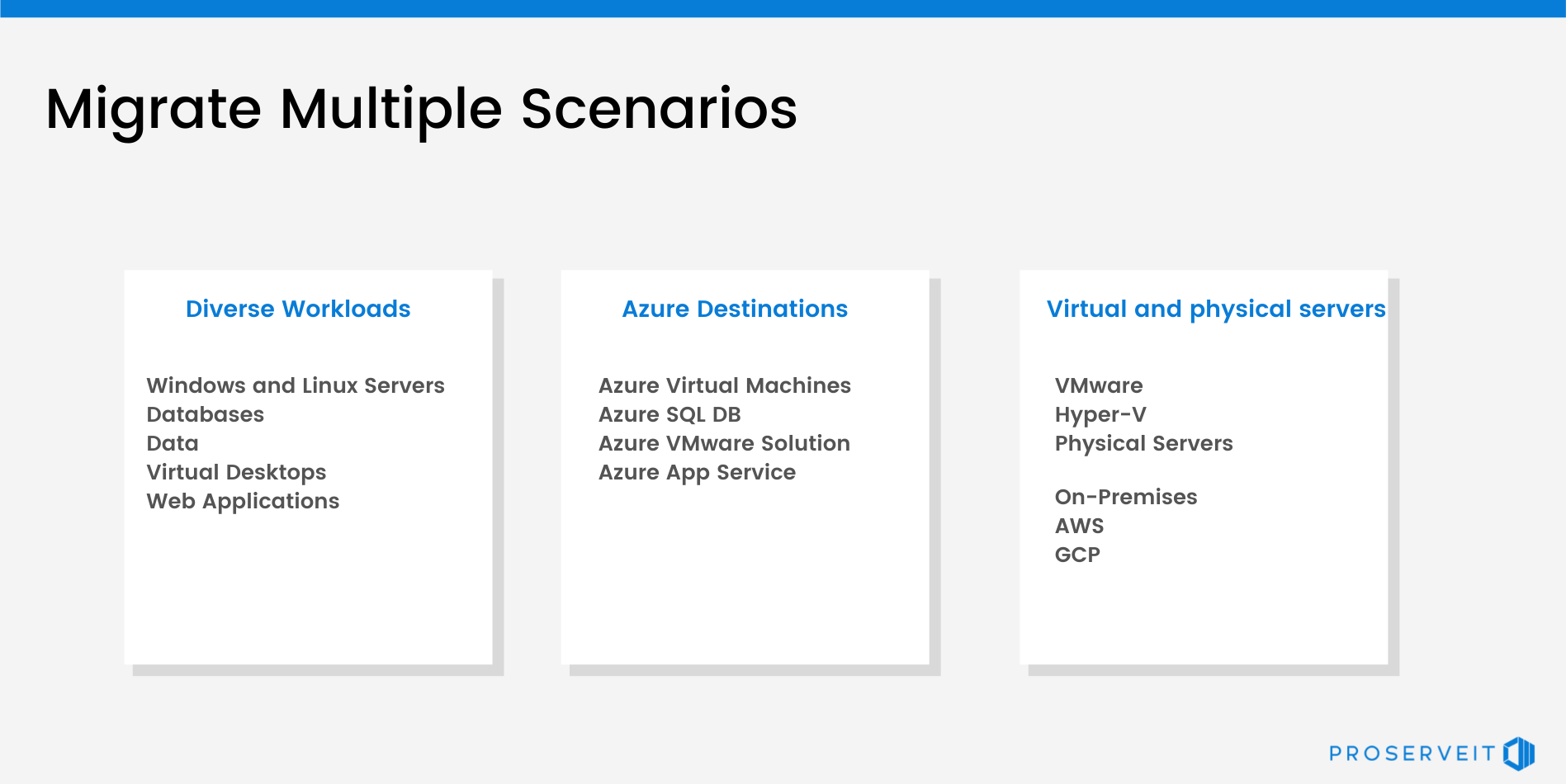 If you're a VMware customer on-prem, Microsoft does have an Azure VMware solution. These toolsets will help you understand how that integration works and how you transition that infrastructure. Also, if you do not want to be artificially constrained by a virtual machine, you can leverage platform as a service or PaaS offerings around app services to support those web apps. Along with on-prem, these toolsets will also facilitate migrations from platforms such as AWS or Google cloud. So, no matter what source platform you're coming from, these tools can easily help and at no additional cost.
If you're a VMware customer on-prem, Microsoft does have an Azure VMware solution. These toolsets will help you understand how that integration works and how you transition that infrastructure. Also, if you do not want to be artificially constrained by a virtual machine, you can leverage platform as a service or PaaS offerings around app services to support those web apps. Along with on-prem, these toolsets will also facilitate migrations from platforms such as AWS or Google cloud. So, no matter what source platform you're coming from, these tools can easily help and at no additional cost.
There are going to be specific scenarios where you might require third-party tool(s) to facilitate a specific workload or a specific challenge. These can be rather rare scenarios, but they do occasionally occur, and this is where the ISV (Independent Software Vendor) tools come into play. The Microsoft tools on the left can help with server assessment and migration database assessment, web app assessment and migration of things, like data box mover, where movers assist with the migration activities themselves.
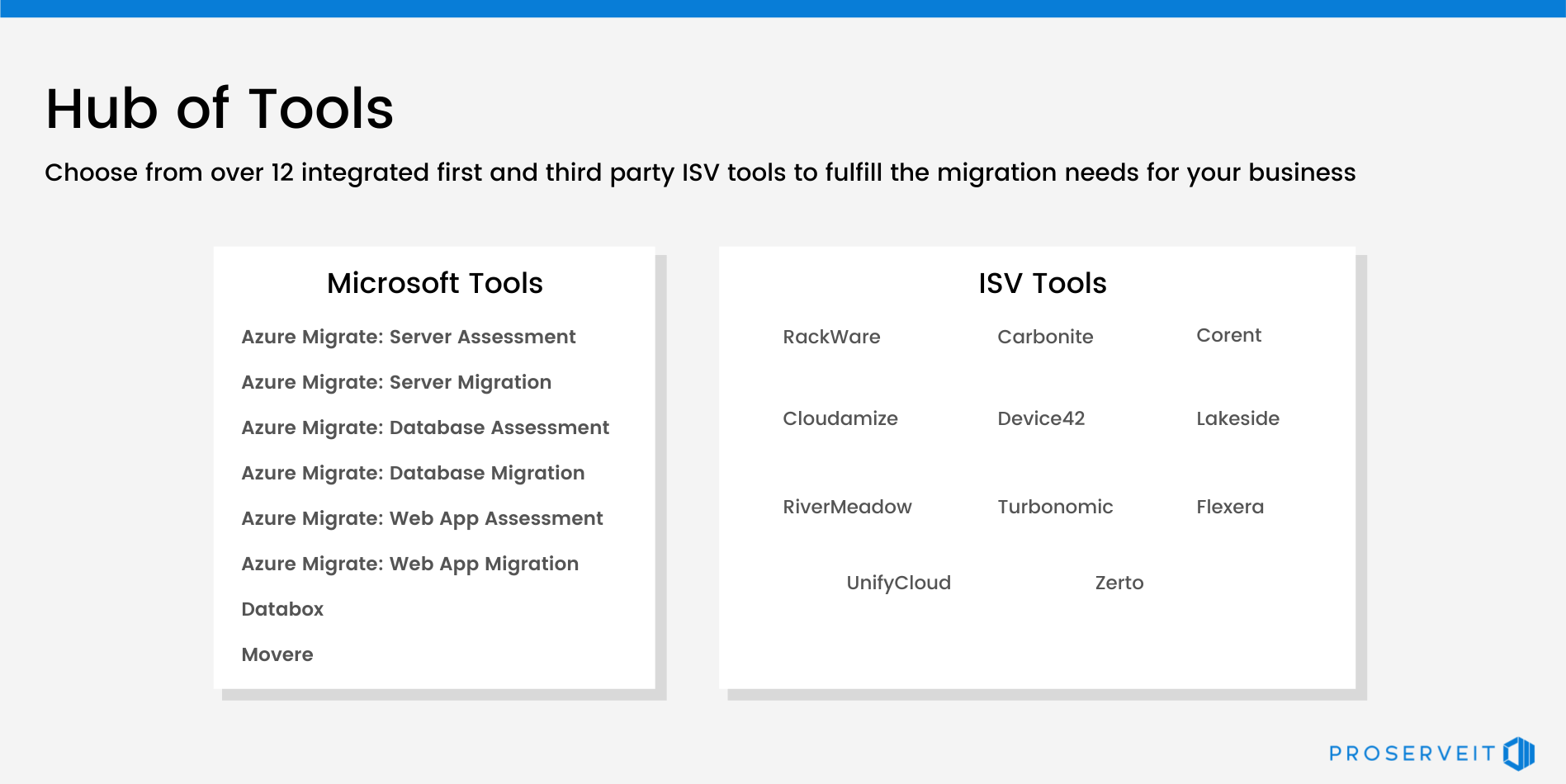 When we talk about Azure migration, the first thing to focus is on assessment along with all the various steps that are involved within the azure migration. So, the intent of an Azure assessment is to help you discover your entire on-premises environment or additional cloud service environments. The intent is just to get a complete understanding of the existing environment that you manage today. It's designed to help you understand what virtual machines and what infrastructure is out there, what sort of dependencies and connections exist and helps you map out what your potential VM sizing, and azure is going to look like in your cloud costs.
When we talk about Azure migration, the first thing to focus is on assessment along with all the various steps that are involved within the azure migration. So, the intent of an Azure assessment is to help you discover your entire on-premises environment or additional cloud service environments. The intent is just to get a complete understanding of the existing environment that you manage today. It's designed to help you understand what virtual machines and what infrastructure is out there, what sort of dependencies and connections exist and helps you map out what your potential VM sizing, and azure is going to look like in your cloud costs.
This really provides the foundation for most of the work needed for transitioning to Azure.
Given that underlying elements sometimes get missed, this assessment process (as we map out our dependencies and connections) allows us to identify any of those outliers.
Azure assessments can also help greatly in estimating cloud costs and VM sizing. On-prem servers are often over-provisioned and can lead to resources staying idle. Right sizing of current utilization of infrastructure can ensure enough headroom for growth and control infrastructure overspend.
Similarly, Database assessments and migrations will help to assess on-prem database readiness, to understand which databases are good candidates for Azure, which are already in an Azure ready state and also provide recommendations on what the Azure sku is going to look like or what the configuration of that VM (virtual machine) should be in Azure. The Azure migrate database assessment also helps to identify workloads that might be good candidates for platform as a service or PaaS and whether they make sense for that business along with removing the artificial constraints of a virtual machine.
Azure Migrate is an end-to-end solution which helps us work from initial assessment through discovery through migration and allows us to create groupings. It also gives better visibility and better management of the overall migration process. It enables us to perform test migrations, pin migrations to Azure availability zones and ensure zero data loss during the migration process.
Are you ready for your Azure Migration Journey?
Migrating to Azure can be a complex process as there are a number of elements that come into play. Some of those elements can be obvious things that you're just naturally going to be aware of and others are not going to be as immediately apparent to you. And this is where leveraging these tool sets like azure migrate or cloud adoption framework can help you drive some of those conversations and make sure you have answers to some of these questions up front.
Many of them can be managed internally, for others you can obviously leverage a partner such as ProServeIT to help manage some of these elements with you, or at least help get you off the ground. Azure Migration can be a complex process and these tools, documentation and technology can help simplify the process of your Azure Migration Journey.
Microsoft also provides free Azure assessments for qualifying customers which you can explore with our free one-on-one consultation and understand what your organization looks like from the readiness perspective and determine whether or not you qualify for that free assessment.
Content from: Azure Fundamentals Webinar Series by Bill Kastner
Edited by: Nikita Gill and Betty Quon
Tags:
March 24, 2022


